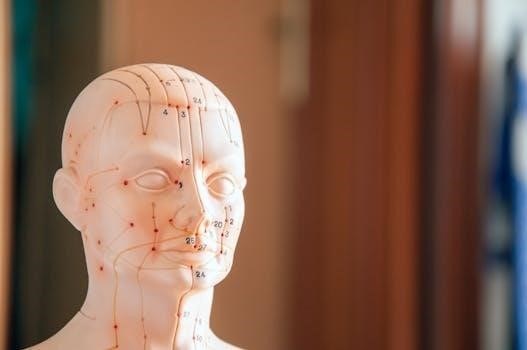BOT-2 Scoring Manual PDF⁚ A Comprehensive Guide
Welcome to a comprehensive guide on the Bruininks-Oseretsky Test of Motor Proficiency, Second Edition (BOT-2) scoring manual. This resource provides essential information for accurate interpretation of BOT-2 results, crucial for professionals administering this assessment.
The Bruininks-Oseretsky Test of Motor Proficiency, Second Edition (BOT-2), is a widely used standardized assessment tool designed to evaluate motor skills in individuals. Primarily used by physical and occupational therapists, the BOT-2 offers a comprehensive measure of both fine and gross motor abilities. Its game-like tasks make it easily administered across a broad age range.
This assessment employs a subtest and composite structure, highlighting motor performance across key functional areas such as stability, mobility, strength, and coordination. The scoring manual is an essential part of the BOT-2 kit, providing the guidelines necessary for accurate interpretation. Clinicians rely on the manual for converting raw scores into meaningful data. The BOT-2 total motor composite correlates with measures like the MABC-2.
Purpose of the BOT-2 Assessment
The primary purpose of the Bruininks-Oseretsky Test of Motor Proficiency, Second Edition (BOT-2), is to provide a comprehensive and reliable evaluation of an individual’s motor skills. Specifically, the BOT-2 is designed to identify motor skill deficits and strengths, which can then inform intervention strategies and treatment planning. It assesses a wide array of motor abilities, including fine manual control, manual coordination, body coordination, and strength and agility.
The assessment is often used to support diagnostic decisions related to motor impairments. By quantifying motor proficiency, the BOT-2 assists in monitoring progress during therapeutic interventions. It aids in research by providing standardized measures of motor performance. The scoring manual is pivotal in ensuring accurate and consistent interpretation of the BOT-2 results.
Target Age Range
The Bruininks-Oseretsky Test of Motor Proficiency, Second Edition (BOT-2), is specifically designed for individuals across a broad age spectrum, making it a versatile tool for assessing motor skills at various developmental stages. The BOT-2 is appropriate for use with children, adolescents, and young adults, spanning from 4 years old to 21 years and 11 months. This extensive age range ensures its applicability in diverse settings, including schools, clinics, and research environments.
The test’s norms are carefully stratified by age, enabling accurate comparisons of an individual’s motor performance relative to their peers. This feature is crucial for identifying developmental delays or motor impairments. The scoring manual provides detailed guidance on interpreting scores within these specific age bands. The BOT-2‘s wide applicability makes it a valuable assessment tool.

Understanding the BOT-2 Scoring Manual
The BOT-2 scoring manual is crucial for accurate interpretation and application of the assessment. It is a guide to understanding the scoring system, ensuring reliable results. Professionals who administer the BOT-2 will find it indispensable.
Importance of the Scoring Manual
The BOT-2 Scoring Manual is an indispensable tool for professionals administering the Bruininks-Oseretsky Test of Motor Proficiency, Second Edition (BOT-2). It serves as a comprehensive guide, ensuring accurate and reliable interpretation of test results. Without the manual, meaning cannot be given to the raw scores captured during the assessment.
The first step in scoring involves determining the client’s chronological age. Scale scores vary depending on age and sex, making the scoring manual essential. It provides the necessary data for scoring and avoids mental calculations. Flipping between pages is eliminated with this resource.
The manual offers insights into descriptive classifications, scaled scores, and percentile ranks, aiding in understanding motor skills. It provides additional fine motor and gross motor scores not available elsewhere. For professionals, this manual is paramount for proper assessment.
Components of the BOT-2⁚ Subtests and Composites
The Bruininks-Oseretsky Test of Motor Proficiency, Second Edition (BOT-2) is designed with a structure that includes subtests and composites. These highlight motor performance across various functional areas. The BOT-2 measures both fine and gross motor proficiency, offering a comprehensive evaluation of motor skills.
The assessment features four main motor skill areas⁚ Fine Manual Control, Manual Coordination, Body Coordination, and Strength and Agility. It contains subtests and game-like tasks, making it easy to administer. The BOT-2 uses a subtest and composite structure that highlights motor performance in the broad functional areas of stability, mobility, strength, coordination, and object manipulation.
This structure provides a detailed understanding of an individual’s motor abilities, aiding in targeted interventions and support. Each composite comprises two of the eight BOT-2 subtests, contributing to a Total Motor Composite score.
Fine Manual Control Subtests
The Fine Manual Control subtests within the BOT-2 are designed to assess precise hand and finger movements. These subtests evaluate a child’s ability to manipulate small objects with accuracy and control, essential for tasks like writing and buttoning clothes. Fine manual control includes fine motor precision.
These subtests measure skills like making dots in circles and folding paper. The Fine Motor Composite conversion tables are located in the BOT-2 Manual Supplement. A scale score is earned on the Manual Dexterity subtest. The scoring manual is an essential part of the BOT-2 kit.
Performance in these areas is crucial for academic success and daily living activities. Accurate scoring of the Fine Manual Control subtests is vital for identifying specific areas of difficulty and planning appropriate interventions to improve fine motor skills. It measures skills like precision.
Manual Coordination Subtests
The Manual Coordination subtests of the BOT-2 focus on evaluating the synchronicity and efficiency of hand-eye coordination and upper-limb movements. These subtests assess the ability to perform tasks requiring the integration of visual input with motor output, such as throwing a ball at a target or catching a tossed object.
The Upper-Limb Coordination subtest is a vital component of the BOT-2 assessment. Manual coordination includes upper limb coordination and associated subscales. A scale score is earned on the Upper-Limb Coordination subtest. The scoring manual provides detailed instructions for administering and scoring these subtests, ensuring accurate measurement of manual coordination skills.
Deficits in manual coordination can impact a child’s participation in sports, games, and other activities requiring precise movements. Identifying and addressing these deficits early on can significantly improve a child’s motor skills and overall functional abilities. It measures hand-eye coordination.
Step-by-Step Scoring Instructions
The BOT-2 scoring process involves several key steps to ensure accurate and reliable results. The first critical step is determining the examinee’s chronological age, as this influences the interpretation of scores and comparison to age-related norms. This calculation requires noting the test administration date and the examinee’s birth date, referencing the scoring manual for precise guidelines.
The next phase includes converting raw scores obtained from each subtest into scaled scores using conversion tables provided in the manual. These tables account for age-related variations in motor proficiency.
The scoring manual is an essential part of the BOT-2 kit, as using it will give meaning to the raw scores you captured during the assessment. Scale scores will differ depending on the childs age and sex, and the scoring manual. Scale scores will differ depending on the child’s age. It is crucial to follow these instructions meticulously to derive meaningful insights from the BOT-2 assessment.
Determining Chronological Age
Calculating chronological age accurately is the foundational first step in BOT-2 scoring, directly impacting subsequent score conversions and interpretations. This process involves subtracting the examinee’s birth date from the date of test administration. Precise calculation is crucial as even small discrepancies can alter the scaled scores and percentile ranks, leading to misinterpretations of motor proficiency.
The BOT-2 scoring manual provides clear instructions and examples for this calculation, ensuring consistency and minimizing errors. Examiners must pay close attention to the format (year, month, day) and handle instances where the day or month of birth is later than the test date appropriately, as outlined in the manual.
Failing to calculate chronological age precisely will compromise the validity of the entire assessment, highlighting the importance of meticulous attention to detail in this initial scoring stage. This step is an indispensable part of the BOT-2 assessment, and using it will give meaning to the raw scores.
Converting Raw Scores to Scale Scores
After determining chronological age, the next crucial step in BOT-2 scoring is converting raw scores from each subtest into scaled scores. This conversion process normalizes the raw scores, accounting for age-related variations in motor proficiency. The BOT-2 scoring manual provides detailed conversion tables specific to each subtest and age band.
These tables are essential for accurately translating a child’s performance on individual tasks into a standardized metric. Examiners must carefully locate the appropriate table based on the examinee’s age and the specific subtest being scored. It’s crucial to cross-reference the raw score with the corresponding scaled score within the table, ensuring precision in data entry.
Using the wrong conversion table or misreading the values can significantly skew the results, leading to incorrect interpretations of a child’s motor abilities. Therefore, meticulous attention to detail and adherence to the manual‘s instructions are vital for accurate scoring, thus, leading to a better final assesment result for the patient.
Using Conversion Tables
The BOT-2 scoring manual provides essential conversion tables for translating raw scores into scaled scores and composite scores. These tables are organized by age ranges and gender, reflecting developmental changes in motor skills. To use the tables effectively, first, determine the examinee’s chronological age accurately.
Next, locate the appropriate table for the specific subtest you are scoring. Find the examinee’s raw score within the table and identify the corresponding scaled score. For composite scores, sum the relevant scaled scores and use the appropriate composite score conversion table to obtain the composite score and percentile rank.
Carefully follow the instructions in the manual, as errors in table selection or score transcription can significantly impact the interpretation of the results. The supplemental manual may contain additional tables for specific composite calculations, ensuring comprehensive scoring. This ensures accurate evaluation and relevant intervention strategies for the patient.

Interpreting BOT-2 Results
Interpreting BOT-2 results requires understanding scaled scores, percentile ranks, and descriptive classifications. These elements provide a comprehensive view of an individual’s motor skills, aiding in identifying strengths and weaknesses for targeted interventions.
Understanding Scaled Scores and Percentile Ranks
Understanding scaled scores and percentile ranks is crucial for accurate interpretation of the BOT-2 results. Scaled scores, typically ranging from 1 to 20 for each subtest, provide a standardized measure of performance, allowing comparisons across different subtests and individuals. A scaled score reflects an individual’s performance relative to their age group, controlling for developmental differences.
Percentile ranks, on the other hand, indicate the percentage of individuals in the normative sample who scored at or below a particular score. For instance, a percentile rank of 75 means the individual performed better than 75% of their peers.
Both scaled scores and percentile ranks are essential for determining an individual’s relative standing in motor proficiency. These scores help professionals understand the significance of raw scores and provide a basis for descriptive classifications and intervention planning. Examining these scores together offers a comprehensive view of the individual’s motor abilities.

Descriptive Classifications
Descriptive classifications in the BOT-2 provide qualitative descriptions of an individual’s motor proficiency based on their scaled scores and percentile ranks. These classifications are essential for summarizing test results and communicating them effectively to parents, educators, and other professionals. Common descriptive categories include “Well Below Average,” “Below Average,” “Average,” “Above Average,” and “Well Above Average”.
Each category corresponds to a specific range of scaled scores and percentile ranks, providing a clear indication of the individual’s performance relative to the normative sample. For example, a “Below Average” classification might indicate that the individual’s motor skills are weaker compared to most of their peers.
These classifications are invaluable for identifying strengths and weaknesses in motor skills and for guiding intervention strategies. By understanding these descriptive classifications, professionals can tailor interventions to address specific areas of need and promote overall motor development. The BOT-2 scoring manual provides detailed guidelines for assigning these classifications.

Resources and Support
To ensure accurate scoring and interpretation, numerous resources are available. These include manual supplements, online platforms, and professional development opportunities. These resources support effective use of the BOT-2 and enhance understanding of motor proficiency assessment.
Manual Supplements
The BOT-2 Manual Supplement is a vital resource, often included in the complete kit or available separately. It offers additional information, including composite scoring tables for both Fine Motor and Gross Motor skills. These tables are essential for converting raw scores into accurate composite scores. The supplement clarifies any ambiguities in the primary scoring manual, ensuring consistent and reliable assessment outcomes.
Professionals find the supplement particularly helpful when dealing with complex cases or specific subtest combinations. It elaborates on scoring nuances, providing detailed guidance for uncommon scenarios. Access to this supplement enhances the practitioner’s ability to interpret the BOT-2 results effectively, ultimately improving the quality of intervention planning. Moreover, it bridges the gap between theoretical knowledge and practical application, solidifying understanding and confidence in using the BOT-2.